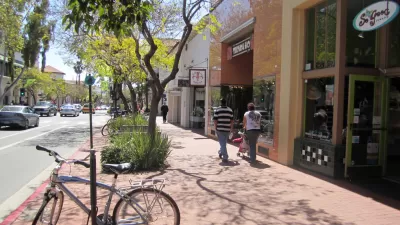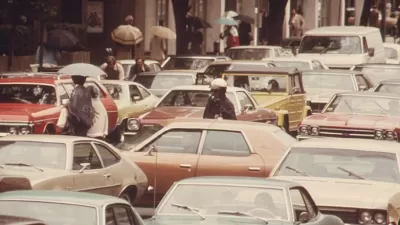Environment
Who Should Pay for Parks?
Philadelphia spends $64 on parks and recreation facilities per resident, one of the lowest totals in the nation. Ryan Briggs uses the city as a lens to examine the growing impact of budget cuts to park systems on their surrounding communities.
Obama's Inaugural Address Cheered by Urbanists and Environmentalists
Matt Bevilacqua found much to cheer in the 'renewed focus on urbancentric topics' that President Obama delivered in his second inaugural address. Climate change, immigration, and inequality were among the speech's primary topics.
10 Innovations Driving America's Cities and States Forward
"America is renewing itself from the bottom up." That is the premise underlying the second annual “Innovations to Watch” list just released by The Brookings Metropolitan Policy Program and The Rockefeller Foundation.
India's Energy and Resources Institute Taking the LEED
India’s foremost environmental think tank is touting a recently developed sustainable building certification program "Green Rating for Integrated Habitat Assessment" (GRIHA) as more holistic than LEED. Could it also help enforce labor laws?
NYC Unveils Plans for Cleaning Up One of Its Most Polluted Waterways
The EPA has released plans for how it intends to clean up Brooklyn's Gowanus Canal Superfund site. Branden Klayko reports on the $500 million, two pronged approach.
Black Carbon Takes No. 2 Spot In Climate Change Agents
31 atmospheric scientists have written a new study on the major component of soot called 'black carbon', long identified with causing respiratory problems - and have shown how it is the 2nd most important agent of climate change after carbon dioxide.
What the Sandy Recovery Bill Gets Wrong
This week, the U.S. House of Representatives approved a two-part bill to fund the recovery from Hurricane Sandy. In an essay written prior to the vote, Rob Young criticizes the rush to approve rebuilding the entire coast as it was before the storm.
Vacancies Leave Obama's Environmental Agenda Unclear
With yesterday's announcement that Interior Secretary Ken Salazar will soon step down, the three top environmental posts in the federal government are waiting to be filled. The vacancies are further muddling the administration's second term agenda.
Wind's Future Remains Uncertain Despite Credit Renewal
While the wind energy credit was extended thanks to the fiscal cliff deal, don't expect to see a flurry of wind projects built and certainly it won't match last year's production. Much uncertainty remains for this renewable power industry.
The Challenge of Bringing Walkability to America's 99 Percent
Kaid Benfield proposes not only more walkable neighborhoods in the United States, where a pedestrian is struck by a vehicle every 7 minutes, but also more walking to reverse the country's alarming obesity trend.
Imminent Doom as Grand Strategy
What do three-pack-a-day smoking habits, triple-decker cheese burgers and sprawl have in common? They all offer immediate gratification and deferred consequences. But now the bill's coming due. Ben Brown lays out some ways to face the music.
Sandy Already Changing How Buildings are Designed in NYC
From roof mounted gas-powered generators to emergency floodgates and watertight mechanical rooms, developers and their designers in New York are already incorporating preventative measures into new and revised designs for their buildings.
LA County Supervisors Propose Pavement Parcel Tax
Facing federal regulatory action for violating Clean Water Act standards, the L.A. County Board of Supervisors will consider a parcel tax weighted towards a property's amount of impervious pavement to fund programs to reduce stormwater pollution.

How Walkable Communities are Key to Modern Geopolitics
The "great global project" of this century, says Patrick Doherty, is how to "accommodate 3 billion additional middle-class aspirants in two short decades." In a bold essay, he outlines how the U.S. must lead the global transition to sustainability.
Affordable Housing with First-Rate Design
Kaid Benfield examines a model 'pocket neighborhood' - Little Rock's Pettaway - which simultaneously improves a declining neighborhood, provides affordable infill housing and applies advanced measures for stormwater control.
Lexington Looks Underground to Guide Downtown Redevelopment
Town Branch Creek was once the lifeblood of Lexington, Kentucky. Now, more than a century after it was rerouted and buried, city leaders want to resurrect the historic waterway as the focal point of downtown redevelopment.
Beijing Smog Levels "Off The Scale"
In Beijing, the level of air pollution is the highest the monitors at the U.S. embassy have ever recorded since put in place in 2008. The pollution results from a combination of weather conditions and particulate matter - most from coal burning.
Impacts of Climate Change More Dire Than Previously Predicted
The draft of a new report issued last week by the U.S. government concludes the impacts of climate change are spreading faster than previously predicted.
Japan Perfects the Art of Delicate Demolition
John Metcalfe looks at how one Japanese company is advancing a more quieter sensitive method for demolishing high-rise buildings, floor by floor.

An Astounding Explanation for Why Big Cities Are More Dangerous Than Small Ones
For decades, researchers have hunted for an explanation for why big cities have been more prone to violent crime than small ones. A new hypothesis may offer a surprising answer, and prove that big cities aren't inherently much more dangerous.
Pagination
Urban Design for Planners 1: Software Tools
This six-course series explores essential urban design concepts using open source software and equips planners with the tools they need to participate fully in the urban design process.
Planning for Universal Design
Learn the tools for implementing Universal Design in planning regulations.
Heyer Gruel & Associates PA
JM Goldson LLC
Custer County Colorado
City of Camden Redevelopment Agency
City of Astoria
Transportation Research & Education Center (TREC) at Portland State University
Jefferson Parish Government
Camden Redevelopment Agency
City of Claremont


































